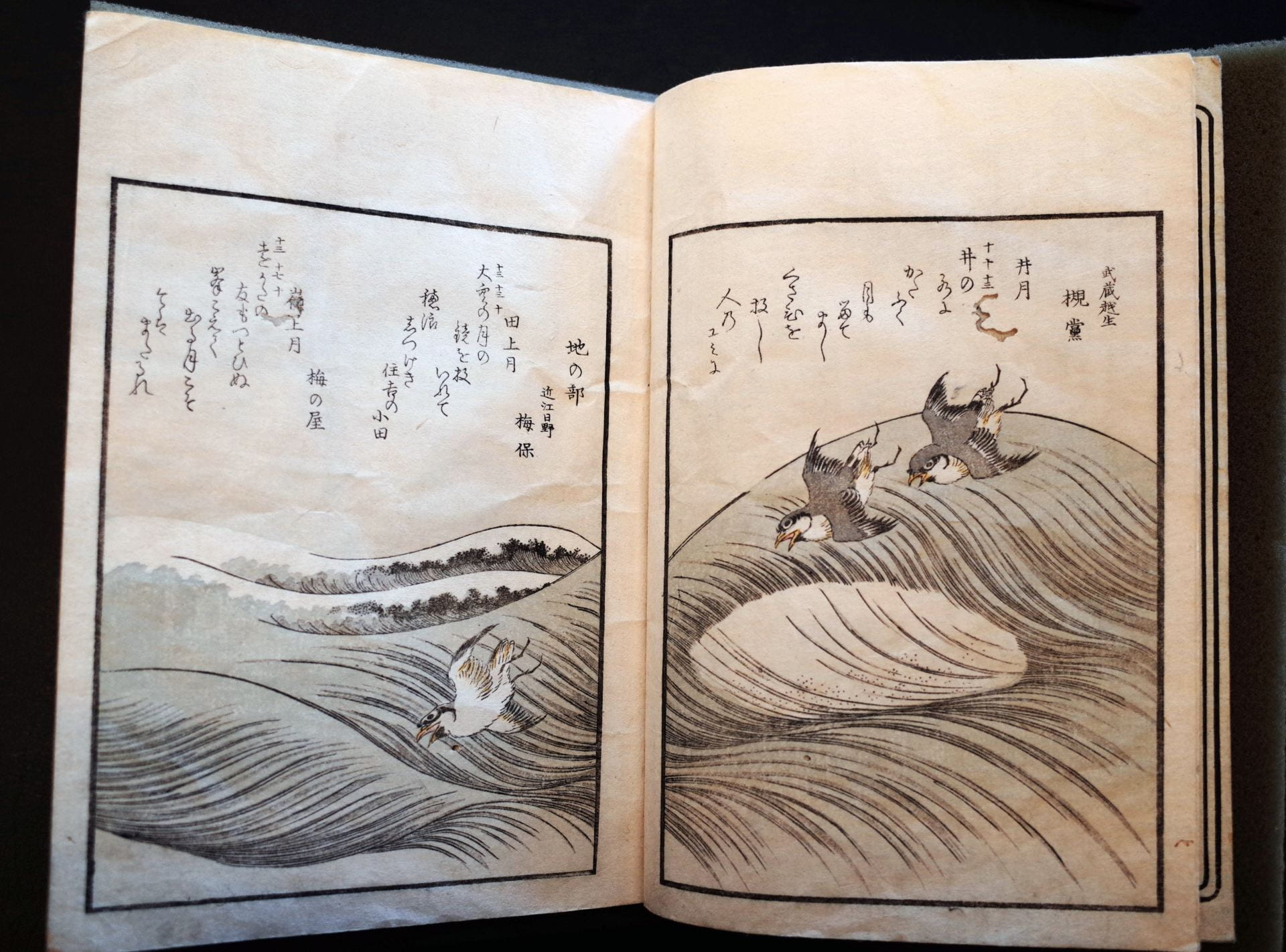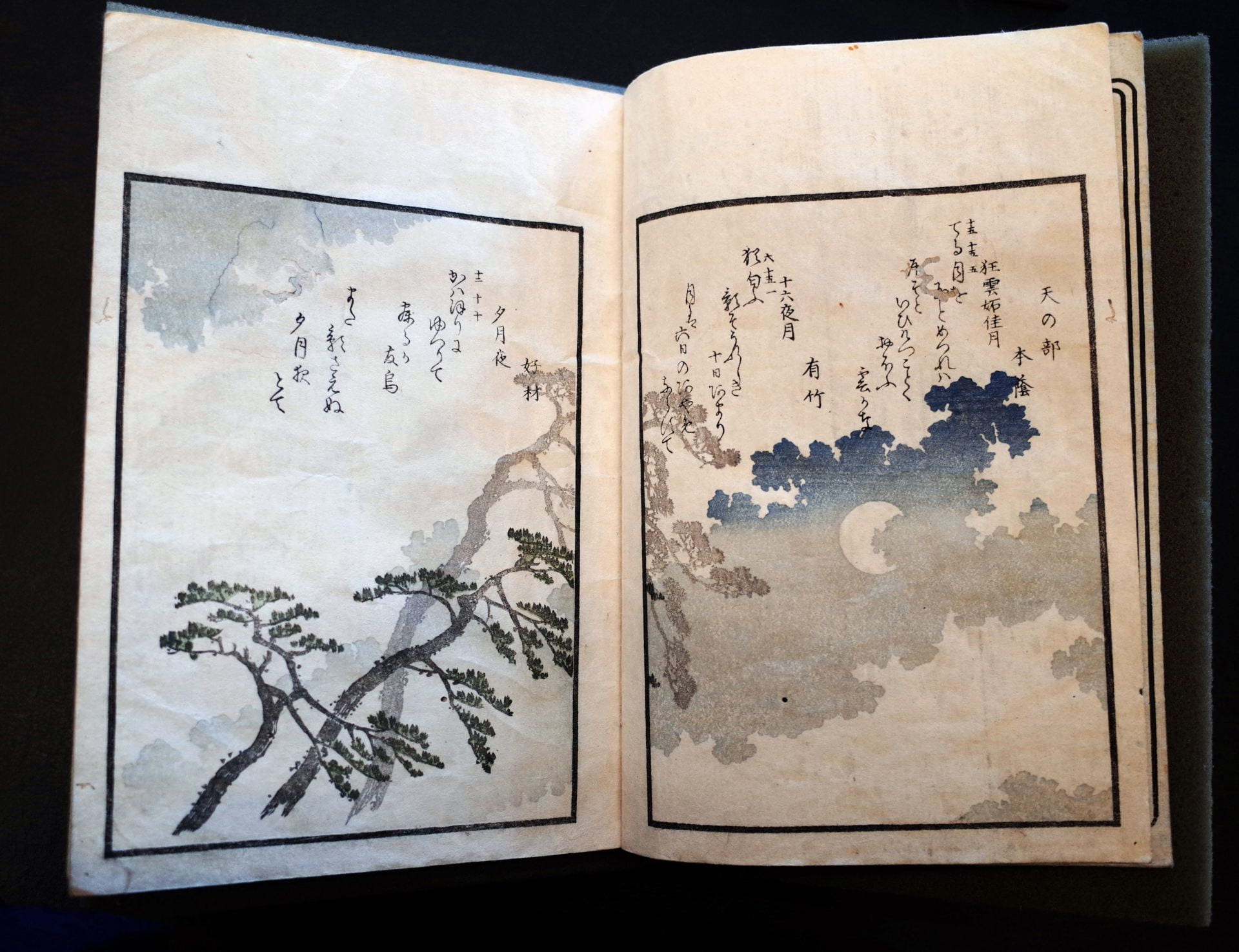Artist: Totoya Hokkei (1780–1850)
Author: Asakusaan Itchibito (aka Asakusa no Ichibito; Sensoan Ichindo)
Title: Sansai tsuki hyakushu
“Three Aspects of the Moon: Collection of One Hundred Verses”
Date: 1826
Publisher: Shun’yūtei
Description: 1 volume with pouch binding; modern case
Medium: Woodblock printed ink and hand coloring on paper; paper cover
Format: hanshibon
Dimensions: 22.5 x 16.2 cm
Location: Kislak Center for Special Collections, Arthur Tress Collection. Box 1, Item 4.
Gift of Arthur Tress
Sansai tsuki hyakushu is a volume of kyōka poetry from a trilogy on the popular theme of setsugekka (snow, moon, flowers). Following the preface, three illustrations by Totoya Hokkei are spread across six pages, along with verse from the Asakusa poetry group. Both the poetry and commissioned illustration interpret the autumnal moon through the concepts of heaven, earth, and man. [1]
Hokkei was a painter and printer who illustrated almost one hundred kyōka collections and other books, and is well known for his single sheet surimono designs. He first studied under Kano Yosen’in and later with Katsushika Hokusai. [2]
Privately published surimono prints and books were created for exchange, sometimes in celebration of the New Year, and in this case perhaps Tsukimi or “moon viewing”—a holiday that honors autumn’s harvest moon. Collections of kyōka were often the result of a competitive writing event, as seen in this volume with three judge’s rankings at the beginning of each poem. Selected by Asakusaan, leader of the Asakusa Group, the top poems appear on the illustrated pages, with the rest printed on following pages in single vertical lines, ranked within each theme. [3]
The sly humor of kyōka often referenced classical themes and literature. Although we have not interpreted the verse (written in kana) the kanji text on the illustrated pages offers clues to the poets’ and Hokkei’s inspiration. Motifs common to all three compositions include the use of positive-negative space for duality, movement/migration indicating passage of time, the moon’s embodiment of reflection/illumination, and groupings of three.
The first illustration shows the heavenly moon in a night sky, partially obscured by silhouetted pine tree foliage, yet illuminating three pine branches in positive relief. The layering of the branches in shades of grey suggests wind and movement, and introduces the idea of time passing. The small area of visible sky is inked in a blue-to-grey ombré; a subtle shade of green appears in the pine needles. Overall, the palette is fairly muted in the style of benigirai-e, with large areas left unprinted or lightly tinted, allowing space for verse. However, the strength of color tints increases through the subsequent illustrations and signal different times of day.
The number of moons increases as well. In the second illustration, though we see only the moon’s reflection in a body of water, it is understood the actual moon is also present, just out of sight. Three chidori (plovers) swoop across the page, leading us to the moon on earth in the well of a wave. There are touches of pale pink in the mouths of the birds, as well as traces of yellow in their beaks and feathers. The waves are tinted with grey and tan.
Finally, the third illustration depicts three moons: we follow a pilgrimage under a moon that is barely visible, yet illuminates two round kasa hats, one glowing brightly atop a kago litter, the other, pale pink, worn by one of the travelers. Descending geese (a popular motif in Japanese painting and prints) are portrayed simultaneously in silhouette against the sky and as shadow over the landscape. Autumnal motifs are represented by the migration of the geese the travelers, and the full moons. The coloring culminates in stronger tints of all colors introduced on the previous pages.
[1] Hillier, J, and Langley Iddins. The Art of the Japanese Book. London: Sotheby’s Publications, 1987, p. 835.
[2] Marks, Andreas. Japanese Woodblock Prints : Artists, Publishers, and Masterworks, 1680-1900. Tokyo: Tuttle, 2010, p. 114.
[3] Kok, D. P. Visualizing the Classics: Reading Surimono and Kyoka Books as Social and Cultural History. Leiden University. Oct. 10, 2017, p. 69.
Other collections
The Gerhard Pulverer Collection
The British Museum
Metropolitan Museum of Art
The Institut national d’histoire de l’art (INHA)
Further reading
Hillier, Jack Ronald. The Art of the Japanese Book. London: Sotheby’s Publications, 1987.
Kok, D. P. Visualizing the Classics: Reading Surimono and Kyoka Books as Social and Cultural History. Leiden University. Oct. 10, 2017
Posted by Catherine Gontarek
November 20, 2019




